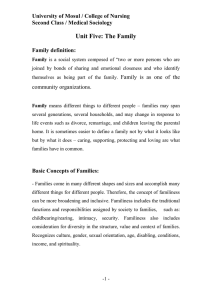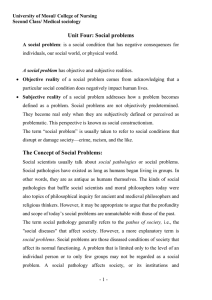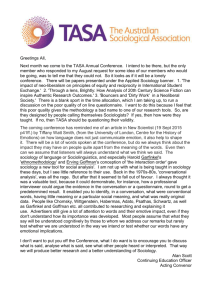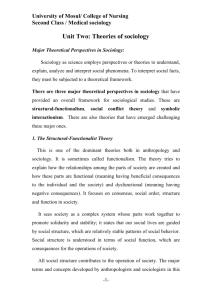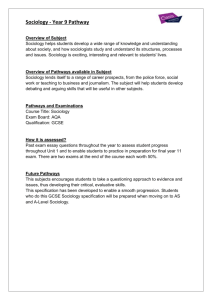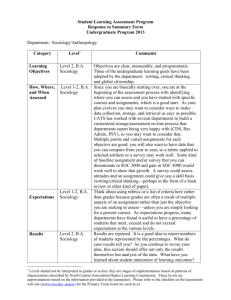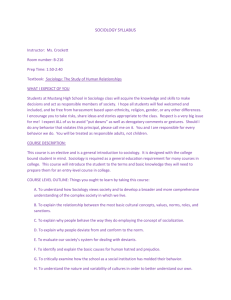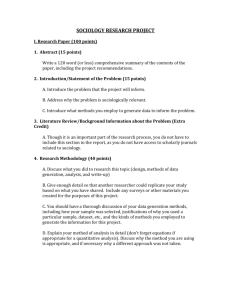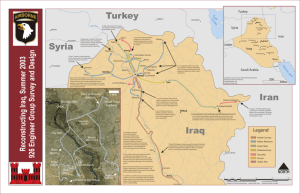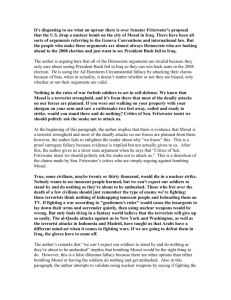College of Nursing Second Class/ Medical Sociology
advertisement
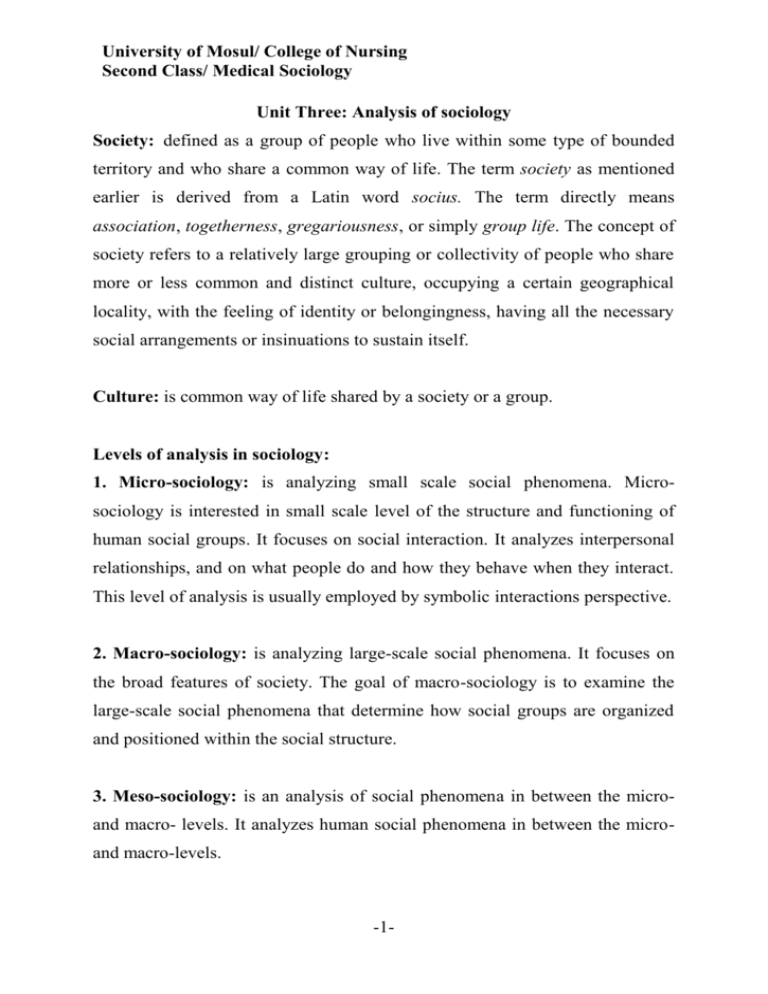
University of Mosul/ College of Nursing Second Class/ Medical Sociology Unit Three: Analysis of sociology Society: defined as a group of people who live within some type of bounded territory and who share a common way of life. The term society as mentioned earlier is derived from a Latin word socius. The term directly means association, togetherness, gregariousness, or simply group life. The concept of society refers to a relatively large grouping or collectivity of people who share more or less common and distinct culture, occupying a certain geographical locality, with the feeling of identity or belongingness, having all the necessary social arrangements or insinuations to sustain itself. Culture: is common way of life shared by a society or a group. Levels of analysis in sociology: 1. Micro-sociology: is analyzing small scale social phenomena. Microsociology is interested in small scale level of the structure and functioning of human social groups. It focuses on social interaction. It analyzes interpersonal relationships, and on what people do and how they behave when they interact. This level of analysis is usually employed by symbolic interactions perspective. 2. Macro-sociology: is analyzing large-scale social phenomena. It focuses on the broad features of society. The goal of macro-sociology is to examine the large-scale social phenomena that determine how social groups are organized and positioned within the social structure. 3. Meso-sociology: is an analysis of social phenomena in between the microand macro- levels. It analyzes human social phenomena in between the microand macro-levels. -1- University of Mosul/ College of Nursing Second Class/ Medical Sociology Elements of society: 1. Earth specific. 2. Population. 3. Time continues like any historical relationship. 4. Minimum of self-sufficiency Societies Classification: 1. Minor classification: e.g. rural, urban, agricultural and industrial society. 2. Advanced classification: primary society, slavery society, feudal society. 3. Comparative classification: it indicators on the basis of the numbers of people in different communities. Social processes: is a set of changes and interactions that lead to the emergence of a recurring pattern of behavior that creates a dynamic movement which put the community in a state of constant change which refers to move the community from case to case. Some of concepts that help to understand the sociology: 1. The concept of social action: is any practice of behavioral to move towards achieving a particular goal within behavioral base approved by the community and by using legitimate means. 2. Actor and the other: is the actor of a person who conduct and the other is the one who receives this behavior that means the social interaction. 3. Social attitude: it is the social context which shows the interaction and includes a series of interactions related to a particular subject. -2- University of Mosul/ College of Nursing Second Class/ Medical Sociology 4. Civil society organizations: are the common area which shared between family, market, and the state, which including: 1. Non-governmental Organizations: is a non-profit organizations that have the structure of an organization or activity, and be registered entities and groups within these institutions. 2. Activist groups: across the Internet, including social media, which can be described as "the organization" and it does not necessarily have to be a physical or legal structure. 3. Social teamwork and matched in principle at work. 4. Religious leaders and religious groups. 5. Unions and labor organizations that represent the workers. 6. Social project owners, who work for society and the environment. 7. Popular assemblies which it is being active at the regional level. Civil society organizations’ roles: 1. Monitoring: civil society organizations have a vital role in monitoring the conduct of the elections and this requires the presence of a broad coalition of organizations which do not have relationship with parties or political candidates. 2. Advocate: civil society plays the role of the lawyer in raising awareness of the issues and challenges of community and to advocate for change. -3- University of Mosul/ College of Nursing Second Class/ Medical Sociology 3. Service provider: the provision of services to meet community needs such as education, health, food, safety and security, and implementation for disaster management and responding in emergencies. 4. Expert: bring the knowledge and unique experiences to format the policies and strategies, and find solutions. 5. Capacity Building: civil society organizations assist to develop of other values of democratic life: e.g. tolerance, moderation, compromise, and respect for opposing points of view. 6. Incubator: developing solutions to conflicts or disputes that may require long time, therefore the civil society organizations play an important role in mediating and helping to resolve the conflict. 7. Representative: give power to the voice of under represented by educating people about their rights and obligations as citizens of a democracy, and encourage them to listen to election campaigns and voting in elections. Basic Features of a Society: First: a society is usually a relatively large grouping of people in terms of size. In a very important sense, thus, society may be regarded as the largest and the most complex social group that sociologists study. Second: as the above definition shows, the most important thing about a society is that its members share common and distinct culture. This sets it apart from the other population groups. -4- University of Mosul/ College of Nursing Second Class/ Medical Sociology Third: a society also has a definite, limited space or territory. The populations that make up a given society are thus locatable in a definite geographical area. The people consider that area as their own. Fourth: the people who make up a society have the feeling of identity and belongingness. There is also the feeling of oneness. Such identity felling emanates from the routinized pattern of social interaction that exists among the people and the various groups that make up the society. Social roles: It is defined as the expectations, duties, responsibilities, obligations, etc, which are associated with a given social status. Every person/ group of persons is/ are expected to behave, act and demonstrate skills, knowledge and attitude that are fitting to the given status or statuses. Every person is expected to play two or more roles. Multiple statuses are associated with multiple roles. The different roles associated with a single status are called role set. Sometimes, there are role conflicts, meaning the clashing of one role with the other. The concept of social role provides a way to name people’s interdependencies. Roles identify the ways that people belong to each other, participate in exchanges with each other, and expect reciprocal responsibility from each other. They identify the contexts in which people learn skills and perform skilfully and the areas of life where people can experience satisfaction and earn status. These role conflicts divide into: 1. Inter-role: i.e. conflict between two or more roles. 2. intra-role conflicts: i.e. conflicts that occur when a person feels strains and inadequacies in accomplishing a certain role, or when there is a gap between what a person does and what a group expects of him or her. Intra-role conflict may also be called role strain. -5- University of Mosul/ College of Nursing Second Class/ Medical Sociology 3. Ideal role: it is the role which a person is expected to perform theoretically. 4. Actual role: it is the role that a person accomplishes according to his or her level of understanding, capacity and personality. Human Rights: 1. Civil rights: rights under the law such as freedom from arbitrary arrest, right to a fair, trial, freedom of speech, freedom to join groups such as trade unions. 2. Political rights: right to vote and to join political parties, right to political representation. 3. Social rights: rights to welfare and health such as a right to receive health care, a right to have access to clean water. Working with Communities: This method of social work is called community organization. It involves the process of creating and maintaining the progressive and more effective adjustment between community resources and community welfare needs. The aim is to make adjustment between the two, which is possible through the effort of professional workers on the one hand, and individuals and groups in the community on the other. -6-


